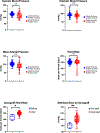The growth of xenotransplanted hearts can be reduced with growth hormone receptor knockout pig donors
- PMID: 34579956
- PMCID: PMC8894505
- DOI: 10.1016/j.jtcvs.2021.07.051
The growth of xenotransplanted hearts can be reduced with growth hormone receptor knockout pig donors
Abstract
Objective: Genetically engineered pigs are thought to be an alternative organ source for patients in end-stage heart failure unable to receive a timely allograft. However, cardiac xenografts exhibit growth and diastolic heart failure within 1 month after transplantation. Grafts function for up to 6 months, but only after administration of temsirolimus and afterload-reducing agents to reduce this growth. In this study we investigated the growth and hemodynamics of growth hormone receptor (GHR) knockout xenografts, without the use of adjuncts to prevent intrinsic graft growth after transplantation.
Methods: Genetically engineered pig hearts were transplanted orthotopically into weight-matched baboons between 15 and 30 kg, using continuous perfusion preservation before implantation (n = 5). Xenografts included knockout of carbohydrate antigens and knockin of human transgenes for thromboregulation, complement regulation, and inflammation reduction (grafts with intact growth hormone, n = 2). Three grafts contained the additional knockout of GHR (GHR knockout grafts; n = 3). Transthoracic echocardiograms were obtained twice monthly and comprehensively analyzed by a blinded cardiologist. Hemodynamics were measured longitudinally after transplantation.
Results: All xenografts demonstrated life-supporting function after transplantation. There was no difference in intrinsic growth, measured using septal and posterior wall thickness and left ventricular mass, on transthoracic echocardiogram out to 1 month in either GHR knockout or GHR intact grafts. However, hypertrophy of the septal and posterior wall was markedly elevated by 2 months post transplantation. There was minimal hypertrophy out to 6 months in GHR knockout grafts. Physiologic mismatch was present in all grafts after transplantation, which is largely independent of growth.
Conclusions: Xenografts with GHR knockout show reduced post-transplantation xenograft growth using echocardiography >6 months after transplantation, without the need for other adjuncts.
Keywords: allotransplantation; cardiac xenotransplantation; diastolic heart failure; echocardiography; growth hormone; heart failure; heart transplantation; hypertrophy; organ growth; physiologic mismatch.
Copyright © 2021 The American Association for Thoracic Surgery. Published by Elsevier Inc. All rights reserved.
Conflict of interest statement
Figures









Comment in
-
Commentary: One more obstacle knocked out.J Thorac Cardiovasc Surg. 2023 Feb;165(2):e82-e83. doi: 10.1016/j.jtcvs.2021.08.008. Epub 2021 Aug 8. J Thorac Cardiovasc Surg. 2023. PMID: 34454734 No abstract available.
References
-
- Längin M et al. Cold non- ischemic heart preservation with continuous perfusion prevents early graft failure in orthotopic pig- to- baboon xenotransplantation. Xenotransplantation 28, (2021). - PubMed
-
- Längin M et al. Consistent success in life-supporting porcine cardiac xenotransplantation. Nature 564, 430–433 (2018). - PubMed
Publication types
MeSH terms
Substances
Grants and funding
LinkOut - more resources
Full Text Sources
Other Literature Sources
Medical

